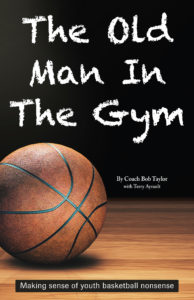Teaching players to attack opponents with both hands
Unless an aspiring young basketball player is lucky enough to be born ambidextrous, a tough learning experience lies ahead. As every coach knows, to be truly successful, a player must be able to cut, pass and dribble equally well to both the right and left. They also must be able to defend right or left against an opponent.
This isn’t news, as most coaches are well aware that they must teach players to be strong on either side. The problem here is that while all coaches know about the necessity of playing both sides, not all are aware of some reliable ways to teach this concept. Just informing players of the importance of having this skill is not enough.
1-on-1 drill
One effective drill that I’ve used to teach dribbling and defending both left and right is simply having players work 1-on-1 up the court against a partner. Three pairs of players, each pair with a ball, line up at intervals along an end line. The player with the ball first works their way up the court, dribbling against their partner’s defense. On crossing the other end line, the defender takes the ball and dribbles back to the original starting point while their partner defends.While this takes place, coaches must stress that players don’t look at ball while dribbling or where they’re planning to go. They should use their off-the-ball hand, focus on the opponent’s body mass, and sneak peeks at where the defender’s eyes are looking. Make sure they also keep a low center of gravity.
Two-lines drill
The old fashioned two-lines drill, if executed properly, are effective in developing opposite hand skills.
The shooting line left of the basket must shoot with the left hand, alternating overhand and under-hook layups. When shooting line players approach the basket from the right side, the right hand takes the shot.
» RELATED: Dynamic drill to help players develop their weak hand
When starting away from the basket, have players take one dribble with their shooting hand, but don’t allow a dribble when shots are closer. We don’t use defense in this drill.
One of our points of emphasis is, after receiving the pass, shooters looking at the basket and not the ball. And, don’t overlook the role of wrist action on under-hook layups or of dropping the wrist on overhead layups.
Defensive drill
 This simple 1-on-1 drill teaches both scoring against aggressive defenses and defending against mid-range jumpers and hook shots. Players pair up, and each pair plays a little game of 1-on-1, taking turns on offense.
This simple 1-on-1 drill teaches both scoring against aggressive defenses and defending against mid-range jumpers and hook shots. Players pair up, and each pair plays a little game of 1-on-1, taking turns on offense.
Two versions should be played. In the first, players on offense start inbounds, facing the defender about three feet back from the middle of the free-throw line. The second version starts when that player posts up inbounds with the ball, back to the defender, just outside the middle of the free-throw line.
Both players get one turn on offense and defense in each version. Offensive scores are worth one point, and the defense scores one point when the player rebounds, blocks or steals the ball. Total score determines the “winner” of the drill.
On offense, make sure players bring the ball to the center of their bodies to begin. Don’t let them look at where they’re planning to go. Use this drill to develop your players’ moves and best shots — jumps, hooks, floaters, layups.
On defense, stress that players keep their feet even, advancing one short step at a time with a foot on the side that’s least likely for the offensive player to attack. Usually, the back foot is on the shooting hand side while facing the opponent and the non-shooting side while guarding a posted-up opponent. Avoid reaching in or hacking, keep hands up and arms out, but don’t lock elbows.
When defending a jump shot by shorter opponent, reach high for a block but come up from below. If the opponent is likely to move laterally, overplay slightly with bodily position. Always keep the knees bent, gravity center low and weight on balls of the feet, except when jumping for a block or rebound.
Scouting
One aspect of going both ways that’s often overlooked is scouting. Always know the handedness of upcoming opponents. The coaches staff usually can collect this information by making notes during film sessions. If this isn’t possible, have someone on staff observe their pregame warm-ups and note it by jersey number. This should be easy to do, since nearly all players will make a pass with the arm of their handedness.
All of your players should go into a game knowing which hand the opponent they’re guarding is more likely to shoot and dribble with, and the direction that they’re most likely to drive and cut. Even if a game plan emphasizes zone defense, this knowledge helps make steals and block shots.
A good rule of thumb for all players — with the exception of mid-range and outside shots — is that both the right and left hands must be equal. That’s only possible if your practice plan and preparation lays the groundwork.









